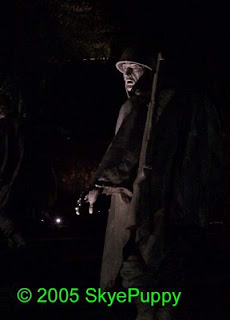The Rule of Thirds
This rule may be the hardest one to get used to, but it will be essential to improving the aesthetic quality of your photos. It means that you divide your viewfinder into thirds, both vertically and horizontally. I'll show you what I mean with this photo I posted when I was on the trip with my mom:

Nice shot. I like it. Now, here it is divided into thirds:

A picture is pleasing when it follows these lines. Like this picture, it doesn't have to be exact. What you don't want is to compose your picture along the lines of crosshairs.
This photo has the classic land/ocean/sky lines loosely corresponding to the horizontal "thirds" lines. That's where you want them. Placing your horizon right across the middle of your photo splits it in half and makes your brain go crazy trying to decide whether it should look at the top or the bottom.
Classic sunset-over-the-water photos either set the horizon line at the lower third-line to showcase the sky, or they set the horizon line at the upper third-line to showcase the reflection on the water.
Back to my photo. The subject (the chairs) is near the right vertical third-line. It's not centered. How did I decide which vertical third-line to choose? The answer brings us to the Bonus Lesson:
Give your subject room to "move" or "look."
The chairs (and presumably you, if you were to sit in them) are looking toward the left, so they need extra space on that side to gaze into. I can't show you this shot with too much space behind the chairs, but just imagine how it would look if the chairs were at the left third-line and all that empty space were behind them. They'd look cramped, as though the poor people who might sit there were forced to sit in the corner by their parents. This would not be pleasing.
Here's another example:

I took this picture (above) at a photography workshop in Washington DC. We went out at night and stopped at the Korean War monument at the Mall. This is one of the statues near the back. You'll notice that although the entire soldier and his backpack, taken together, are on the right side of the picture, the highlighted portions follow a vertical line right down the center.
In Photoshop, I cropped off a bit of the right edge to pull the highlights to the right (allowing him as much room as possible to look and walk to the left), and I took a bit off the top to keep the photo the right shape (not too skinny). Here is the result:

The difference may be subtle, but the second image is the better photo.
The reason the Rule of Thirds is difficult to follow is that most cameras are designed to make it easy for you to place your subject in the crosshairs. That's where they look for autofocus.
To get the focus right and still compose your pictures along the third-lines, you'll need to use the halfway-down feature of your camera's shutter button. Cameras with autofocus let you center the subject and push the shutter button halfway. This makes it focus without taking the picture, and it shows you the result in the viewfinder. As long as you keep the button halfway down, the focus stays locked in. By doing this (even if you want to center your subject), you can make sure your camera is going to focus the photo the way you want it to. No more thinking you've focused on your daughter, only to find out the camera was slightly off-center, and it focused on the table lamp three feet behind her, leaving your little angel a fuzzy blur.
Here's the process:
1. Center your subject, push the shutter button halfway, and keep it there.
2. Check to be sure the camera is focused in the right place. If not, redo step 1 until it's focused right.
3. Keeping the shutter button halfway, move the camera to compose your photo along the third-lines.
4. Push the shutter button the rest of the way down.
One thing that can help you compose your pictures is to change the settings on your camera to show you the third-lines in your viewfinder. Not all cameras have this feature, but if yours does, make the change. Not only does it help you place your subject better, it also helps keep you from coming up with tilted horizon lines.
Homework:
1. Analyze. Do an image search in Google (or your favorite image website) on a topic of your choice. Look at many of the resulting images. Decide if you like the picture, then determine how (or whether) that picture follows the Rule of Thirds. Think about how you might be able to take pictures similar to the better ones.
2. Feel. Look at the world through your camera's viewfinder--you don't even have to take any pictures--and compose "pictures" that follow the Rule of Thirds. Start getting used to seeing potential photos in thirds. Then practice holding the shutter button halfway down while you move the camera around. Do this until you have a good feel for it and aren't accidentally taking pictures or lifting your finger and undoing the focus.
3. Practice. Take pictures that follow the Rule of Thirds. If you like some and want to share, post them on your blog and leave a comment here with the link.
Have fun!
2 comments:
I just wanted to thank you, Skye, for giving us these tips and teaching us.
Also, using digital cameras make our homework fast and easy. We don't have to wait and have our film developed only to find blurry subjects and bad shots.
Janice,
You're welcome. I'll take any chance I can get to talk about photography.
And about that film, I believe I still have some film canisters I haven't developed, and it's been over 10 years. Digital photography lets me actually see my photos...
Post a Comment